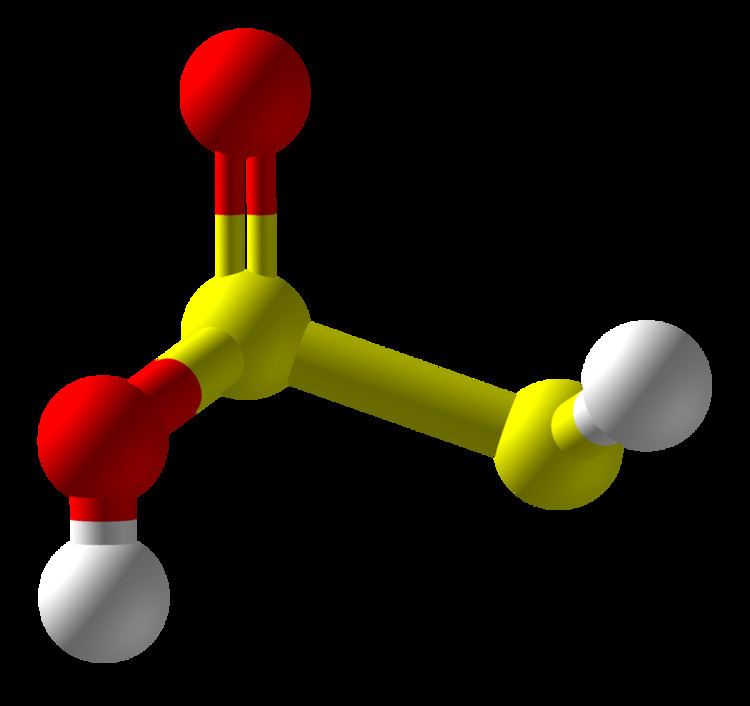ChemSpider ID 7827575 | ||
 | ||
Related compounds | ||
Thiosulfurous acid (HS-S(=O)-OH) or sulfurothionous O,O acid is a low oxidation state (+1) sulfur acid [ (+1) is the average oxidation state of the two structurally different sulfur atoms . The exterior atom has a oxidation number of (-1) while the central sulfur atom has the oxidation state of (+3) ]. It is termed a disulfur(I) acid. It is the equivalent acid for disulfur monoxide. Thiosulfurous acid is formed by reacting hydrogen sulfide and sulfur dioxide at room temperature. The thiosulfurous acid molecule is unstable when condensed, reacting with itself.
Contents
It decomposes to polysulfane oxide or polythionic acids in water which is termed Wakenroder's liquid.
Other possible isomers are dihydroxydisulfane or hypodithionous acid HOSSOH, a linear chain, and thiothionyl hydroxide (S=S(OH)2) a tautomer where the hydrogen has moved from a sulfur to an oxygen. HOSSOH can have two different rotamers with symmetry C1 and C2. The isomer with one hydrogen on sulfur and one on oxygen is the most stable according to calculations.
Reactions
Thiosulfurous acid can be formed during the hydrolysis of disulfur dichloride.
In alkaline conditions Thiosulfurous acid rapidly deteriorates forming a mixture of sulfide, sulfur, sulfite, and thiosulfate. In acidic conditions it will form hydrogen sulfide and sulfur dioxide as well. Some of these react to form pentathionate and other polythionates. Thiosulfurous acid reacts with sulfurous acid to give tetrathionate, and with thiosulfuric acid to make hexathionate.
Salts
Salts of thiosulfurous acid are named "thiosulfites" or "sulfurothioites". The ion is S=SO22−. However they are unknown.
Esters
Four isomers are possible for R2S2O2, at least restricting sulfur to di- and tetravalency: (RO)2S=S, ROSSOR, RS(O)2SR, and RS(O)SOR. For the first two, the R groups are equivalent, and in the latter two they are nonequivalent. A simple example is diethylthiosulfite, (EtO)2S=S. It is also known as diethylthionosulfite. It is a stereochemically rigid on the NMR timescale to about 140 ºC, somewhat similar to diethylsulfoxide. Many derivatives have been prepared from glycols. From meso-hydrobenzoin (PhCH(OH)-CH(OH)Ph), one obtains two isomers; a third isomer results from d,l-PhCH(OH)-CH(OH)Ph.
The reaction with simple alkoxide sources with disulfur dichloride gives the unbranched ROSSOR. They are immicible in water, but dissolve in benzene or carbon tetrachloride. These species are less rigid that the thiosulfite esters.
